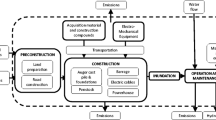Abstract
The building of Shuikou Hydropower Station in the Minjiang River is the largest one in the region of east China. Its install capacity is 1.4 million kw., and its generated energy of planning is 4.95 billion kwh each year. In accordance with a comprehensive survey of the valley of the middle-lower reaches of the Minjiang River and the characteristic of hydrography and in association with the specific type of the hydrography station, we can be sure that no harm will be done to the ecological environment when a hydropower station is built at Shuikou. Not only the deposition of silt within the reservoir must not be very serious, it is also more favorable than before for the irrigation of farmland on plains in the lower reaches of the Minjiang River and inland navigation.
In addition, after the completion of the power station, the ecological environment will be the same as before both at the Minjiang River estuary and beyond it.
Similar content being viewed by others
References
余泽忠, 福州盆地内;江下游洪水与潮流的关系, 福建师院学报, 1959.
余泽忠、 余兆康, 江下游和 江口若干水文现象及 同水利的关系, 福建师院学报, 1964.
Author information
Authors and Affiliations
Rights and permissions
About this article
Cite this article
Yu, Z. A prediction about the effect of the building of Shuikou Hydropower Station on the ecological environment of the middle-lower reaches of the minjiang river. Chinese Geographical Science 1, 248–261 (1991). https://doi.org/10.1007/BF02664519
Issue Date:
DOI: https://doi.org/10.1007/BF02664519




